This page contains affiliate links. Please read our disclosure for more info.
During our two weeks in Japan we experienced as much as possible of what the country has to offer.
From the neon lights of Tokyo to the wooden teahouses of Kanazawa; from driving go-karts dressed as Mario characters to the solemn and tranquil tea ceremony; from steaming bowls of cheap ramen to exquisite kaiseki cuisine; from temples, mountains and rice paddies to bullet trains, skyscrapers and arcades.
We fell in love with the country even more than on our first visit.
In this detailed Japan 2 week itinerary, I share exactly where we went, how we got there, where we stayed and ate, and a map of our route.
This trip is ideal for first-time visitors to Japan as it covers the highlights (modern Tokyo, traditional Kyoto, stunning Mount Fuji) as well as some less-visited gems.
It also works well for return visitors like us who want to revisit their favourite spots and make some new discoveries.
Contents
- Video: Japan Highlights
- Our Japan Itinerary Summary
- Japan Two Week Itinerary Map
- Getting Around Japan
- Days 1 – 5 Tokyo
- Day 6 Nikko
- Day 7 Hakone
- Days 8 – 9 Takayama
- Days 10 – 11 Kanazawa
- Days 12 – 16 Kyoto
- Alternative Japan Destinations
- Japan Travel Resources
- Summary
- Japan Travel Blog Posts
Video: Japan Highlights
Watch our video for ideas on how to spend two weeks in Japan.
Our Japan Itinerary Summary
- Tokyo – 3-5 nights (stay in Hotel Century Southern Tower in Shinjuku)
- Nikko – 1 night (stay at Nikko Park Lodge Tobu Station)
- Hakone – 1 night (stay in an onsen ryokan such as Yoshimatsu)
- Takayama – 2 nights (stay at Super Hotel Hida Takayama)
- Kanazawa – 2 nights (stay at Kaname Inn Tatemachi)
- Kyoto – 3-5 nights (stay at Sora Niwa Terrace downtown or The Celestine in Gion)
Our trip was at the end of September until mid-October and was actually for 16 nights, but you could easily cut this down to 14 days in Japan by spending less time in Tokyo.
Our Japan itinerary included five nights in Tokyo, six nights travelling with a 7 Day Japan Rail Pass, and ended with five more nights in Tokyo.
We spent over three weeks in Kyoto on our first trip so we didn’t visit this time, but if you are new to Japan, I highly recommend substituting the second Tokyo stay with Kyoto as it really is a must-see.
See my detailed guide to the best things to do in Kyoto for lots of tips.
There are so many amazing places to visit in Japan. At the end of this post I have included other suggested destinations if you decide to get a 14 Day Rail Pass for your two weeks in Japan and add more places to your itinerary and reduce the time spent in Tokyo or Kyoto.
On this trip, we moved at a much quicker pace than usual. The week travelling with a rail pass was especially exhausting and we could easily have added an extra night (or two) to everywhere we visited.
That said, we don’t regret our itinerary as we had an amazing time.
Japan Two Week Itinerary Map
This map shows our 2 week Japan itinerary with blue markers and other potential destinations to consider with red markers.
Getting Around Japan
Trains are the best way to get around Japan and we travelled with a 7 day Japan Rail Pass.
Unfortunately, these aren’t as good value as they used to be. They can still save you money (or break even) especially if you travel a lot on the fast bullet trains (which are one of the best things to do in Japan).
You can use the Navitime website to find train times and costs and compare these to the cost of a pass.
If the cost is close, get the pass as it’s much easier being able to hop on and off trains when you like and not worry about purchasing tickets.
You need to book Japan Rail Passes in advance before you arrive in Japan. You’ll receive an exchange order in the mail that you then exchange for the pass in Japan.
We booked ours with JRailPass.com who deliver anywhere in the world, including to your first Japan hotel if you’ve left it to the last minute. We got ours delivered to a hotel in Bali.
See my detailed guide on how to calculate whether a Japan Rail Pass is worth it including everything you need to know to use the pass. It includes a cost breakdown for this exact Japan 2 week itinerary.
Days 1 – 5 Tokyo
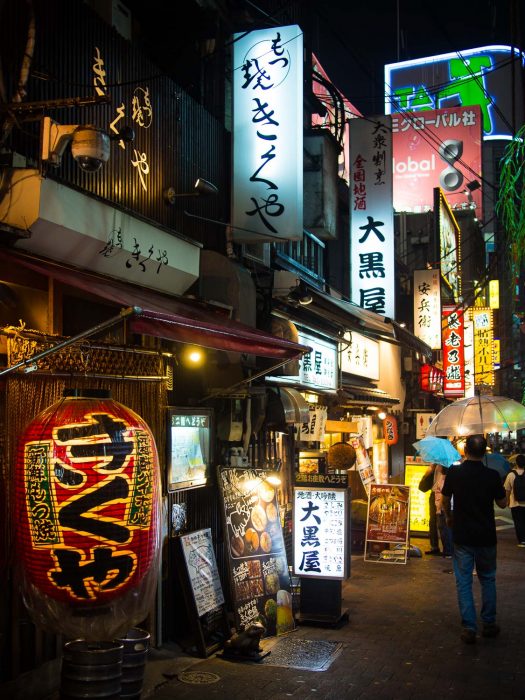
It’s easy to spend five days in Tokyo, but if time is limited you could reduce your stay to three.
It’s a huge sprawling city so it’s best to focus your explorations on neighbourhoods.
Here are some of my recommendations and you can see my guide to the coolest things to do in Tokyo for more details.
Shinjuku Day
- Shop in huge electronics stores like BIC Camera and the food basements of department stores like Takashimaya.
- Stroll around the beautiful Shinjuku Gyoen National Garden (having a picnic here is one of our favourite things to do in Shinjuku).
Shinjuku Night
- Eat in a tiny restaurant on atmospheric Memory Lane.
- Lost in Translation fans should drink with a view at the NY Bar at the Park Hyatt Hotel.
- Bar hop on the Golden Gai.
Shibuya and Harajuku
- Walk across the famous Shibuya Crossing.
- Gawp at the crazy fashions of Takeshita Street.
- Enjoy stunning ukiyo-e woodblock prints at the Ota Memorial Museum of Art.
- Visit the Meiji Shrine in Yoyogi Park.
- Sample exquisite green teas at the serene Sakurai Tea Experience.
- Gaze at the stunning view from Shibuya Sky at sunset (book weeks in advance for the prime slot).
Asakusa
- Step back into old Japan and get your fortune told at Sensoji Temple.
- Enjoy a meal in a traditional restaurant (we had a 12-course vegetarian feast at Bon).
Rest of Tokyo
- Spend a day at the magical DisneySea or Tokyo Disneyland parks.
- Visit the Ghibli Museum if you are a Studio Ghibli fan (tickets must be booked on 10th of the month for the following month).
- Immerse yourself in the colourful digital art museums, TeamLab Planets or TeamLab Borderless. See our TeamLab Planets guide for a comparison of the two.
- Take a fun go-karting tour driving the Tokyo streets dressed as your favourite character!
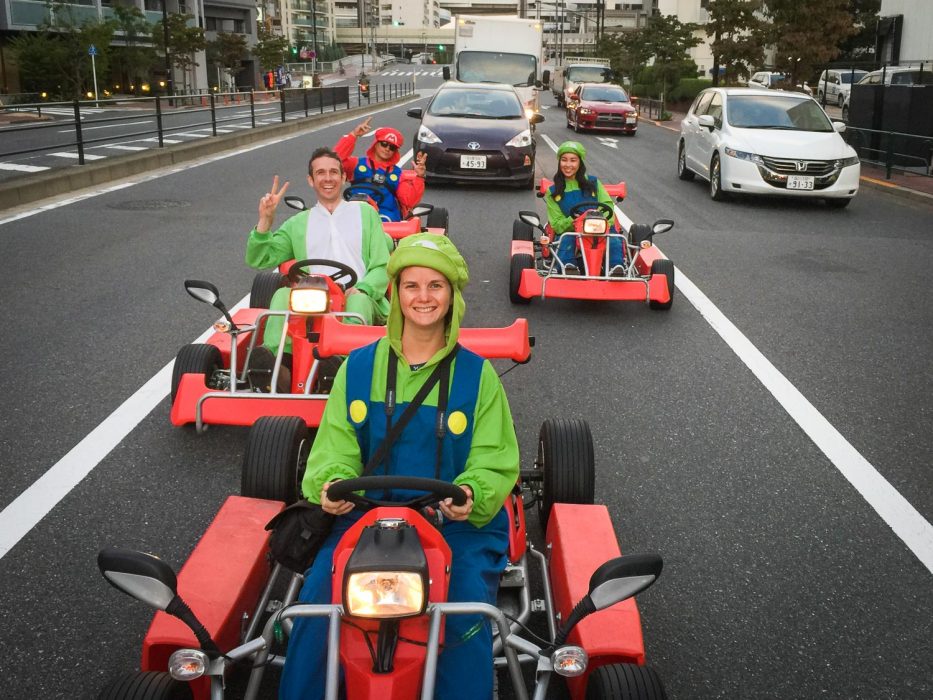
Tokyo Transport
The Narita Express train is the easiest way to get from Narita airport to Shinjuku, Shibuya and Tokyo stations.
It costs 3250 yen ($21) and takes 87 mins to Shinjuku. You must have a seat reservation but you can get this when you buy the ticket from the machine or counter in the airport station.
The Japan Rail Pass is valid on this line, but if you are following this itinerary with a 7 day pass you won’t want to activate it until the day you leave Tokyo.
A Suica card is the best way to ride all trains and metro lines in Tokyo (and local transport elsewhere in Japan). You can also use it for lockers, vending machines, and even in many shops.
Due to a chip shortage, only the tourist Welcome Suica cards are available. If you have an iPhone, get a digital Suica on Apple Wallet instead.
If you will be using a Japan Rail Pass during your stay, make sure you swap your exchange order for a pass and activate it at one of the JR offices in train stations. You can’t change the start date once you have done this.
Where to Stay in Tokyo
Shinjuku is our favourite area to stay in Tokyo as it has excellent transport links, good food, and many of the attractions above are in walking distance.
On our latest trip we stayed at Hotel Century Southern Tower and loved its location near Shinjuku Station and the incredible views from some rooms (we recommend the Panoramic King room).
Shibuya is another convenient base, but we found it too crowded.
Search for more hotels in Tokyo here.
Where to Eat in Tokyo
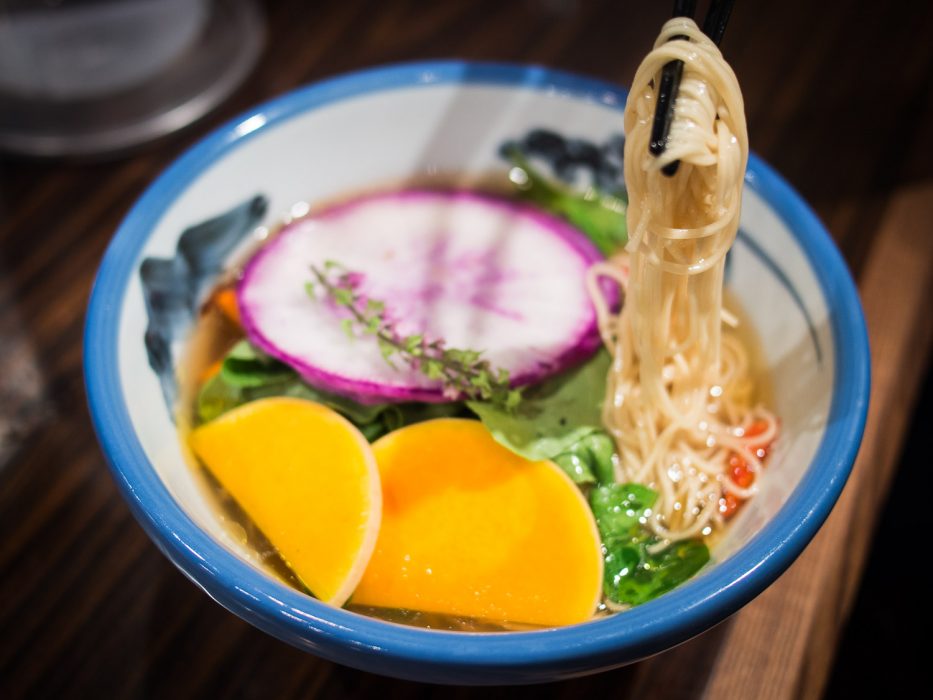
There is so much amazing food in Tokyo from cheap eats to fine dining. Even as vegetarians we ate really well with some planning.
See my post on our favourite Tokyo vegetarian restaurants. The highlight was Bon which serves exquisite multi-course Zen Buddhist cuisine in private tatami rooms—it’s an experience more than just a meal.
Day 6 Nikko
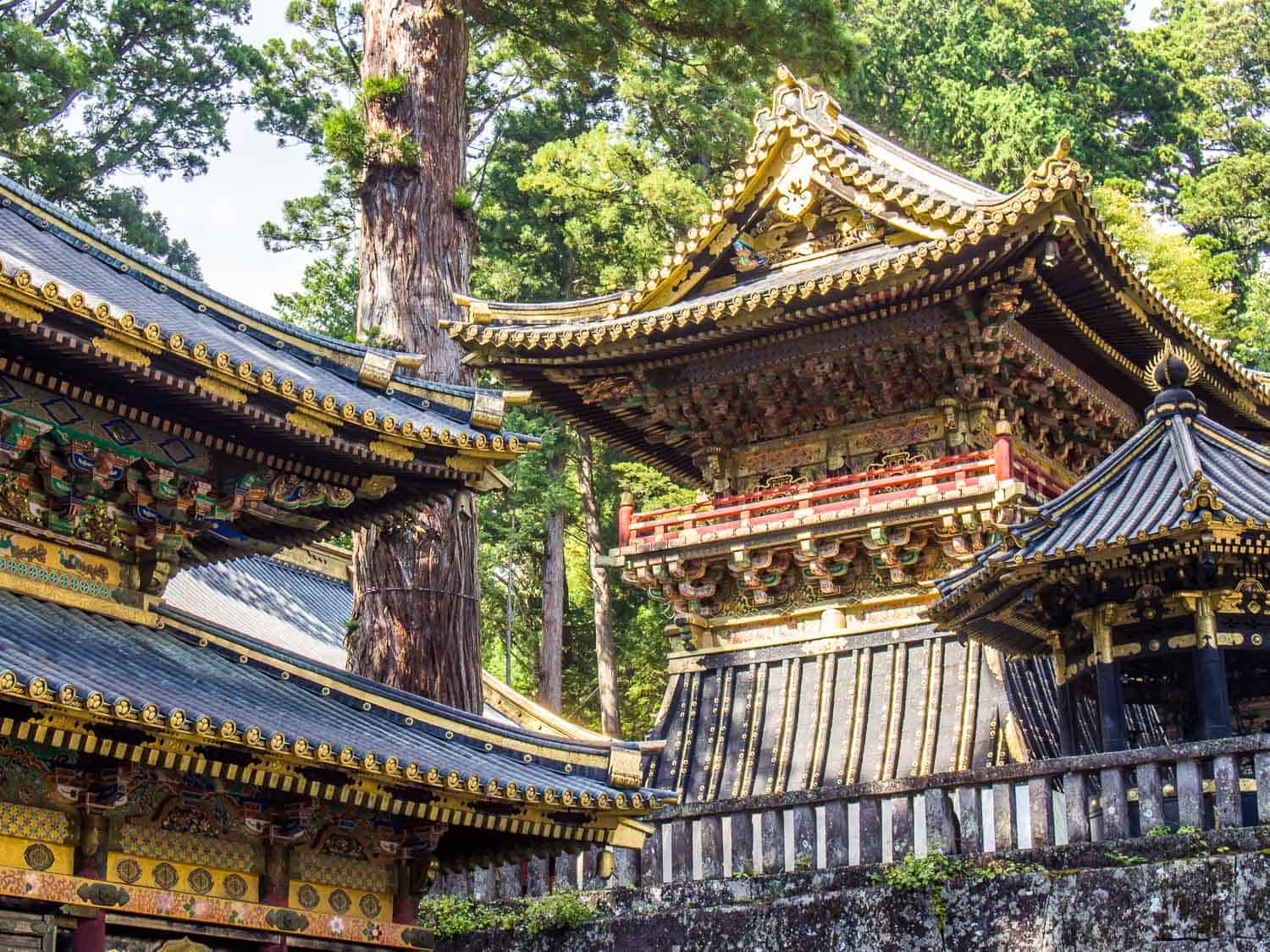
On Day 6 we activated our Japan Rail Pass and headed off early to Nikko, a temple town in the mountains a few hours north of Tokyo.
Many people visit on a day trip from Tokyo, but as it’s a fairly long trip we decided to stay the night.
The air felt cool and fresh and it was lovely to see mountains after Tokyo’s concrete jungle.
From the train stations, it’s a 30-minute walk along the main road to the bright red Shinkyo bridge and the temples start up the forest-covered hill just beyond.
Nikko’s shrines and temples are a UNESCO world heritage site.
Toshogu Shrine is the most famous Nikko attraction and is the final resting place of Tokugawa Ieyasu, the founder of the Tokugawa Shogunate that ruled Japan for over 250 years until 1868.
It’s one of the most stunning temples I’ve ever visited with more than a dozen intricately decorated red and gold buildings amongst huge cedar trees (some over one thousand years old).
But on a Sunday it was overwhelmingly busy and we didn’t stay long.
Luckily Nikko has many other shrines to explore that are much quieter than Toshogu.
Although they are less spectacular we had a more enjoyable experience at Futarasan-jinja shrine, Taiyuinbyo temple, and up the mountain at Takino shrine.
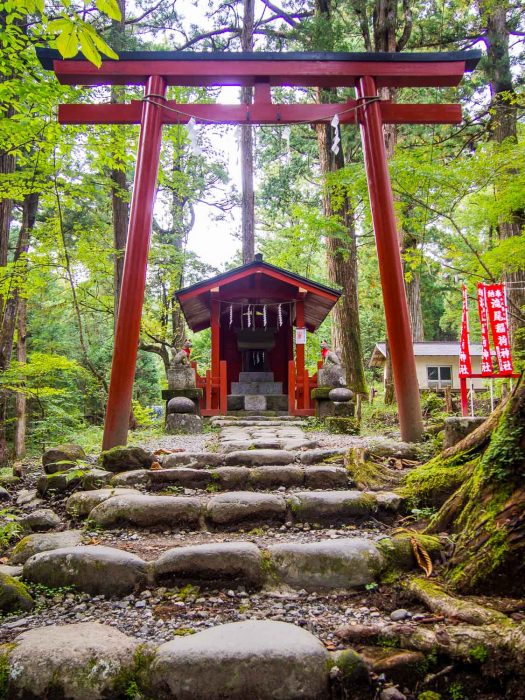
Although half a day at the temples was enough for us, it would have been better to visit Toshogu first thing in the morning before the day-trippers arrived.
With more time we could also have done some nearby hikes.
Nikko Transport
Nikko has two train stations that are a few minutes’ walk from each other.
Tobu Nikko Station is served by Tobu Railway trains and Japan Rail Passes can’t be used on this line, so with a rail pass you’ll arrive at the JR Nikko station. There are lockers at both stations where you can leave luggage.
From Tokyo, I recommend getting the bullet train from Tokyo Station to Utsunomiya then changing for the local train to Nikko—there were even friendly staff at Utsunomiya showing us where to go. The whole journey takes about two hours.
Don’t make the mistake we did on the way there and take the JR Shonan-Shinjuku line from Shinjuku to Utsunomiya. This is a local line so is busy and not very comfortable for the long trip. It took us three hours to get to Nikko.
The Nikko train stations are about a 30-minute walk from the temple area or you can take the bus. We walked everywhere.
I recommend picking up a tourist map from the train station as not all the temple signs are in English.
Where to Stay in Nikko
We stayed at budget-friendly Nikko Park Lodge Tobu Station which has a convenient location close to the train stations.
We chose the most expensive triple room with private bathroom, but there are cheaper rooms with shared bathroom.
The decor was rather dated, but the bed was comfortable and it was spacious by Japanese standards with a double bed, single bed, armchair, and kitchenette (although no plates or pans were provided).
Breakfast costs extra but there’s a big supermarket close by.
Search for more accommodation in Nikko here.
Where to Eat in Nikko
For a snack, try dango, grilled rice balls on a stick brushed with miso or soy, which are sold at a few stands on Nikko’s main road.
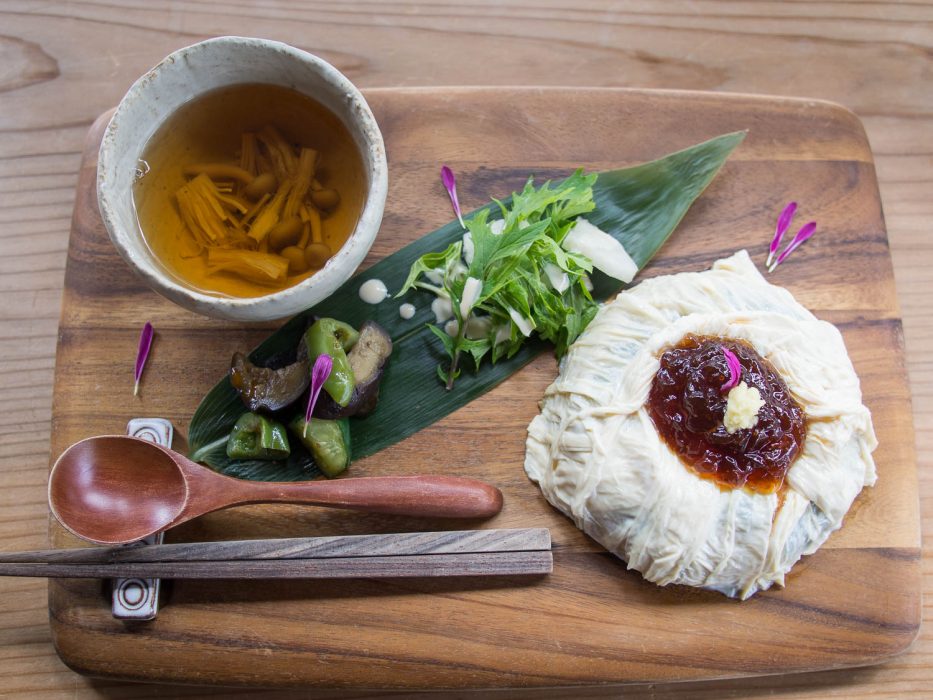
We had lunch at Meguri, a mostly vegan cafe in an old art gallery with a beautiful painted ceiling.
It’s on the main road not far from the temples—look for the sign that says “Oriental Fine Arts & Curios”.
We had a lunch set, but it looks like they now focus on coffee and vegan crepes.
Many restaurants in Nikko close in the evening so Komekichi Kozushi was a great find just a few minutes’ walk from our hotel (and the train stations).
This small family-run sushi place has two tables, counter seating and a tatami room where we ate.
It was the first sushi place we found in Japan that had plenty of vegetarian options on the English menu including pickled plum, pickled vegetables, natto, cucumber, and egg.
They even have an English guide to sushi etiquette, so you don’t make a faux pas like dipping the rice end of your sushi in soy sauce.
We loved the pickled vegetable sushi and especially the inari zushi—tofu stuffed with rice. It was excellent value.
Day 7 Hakone
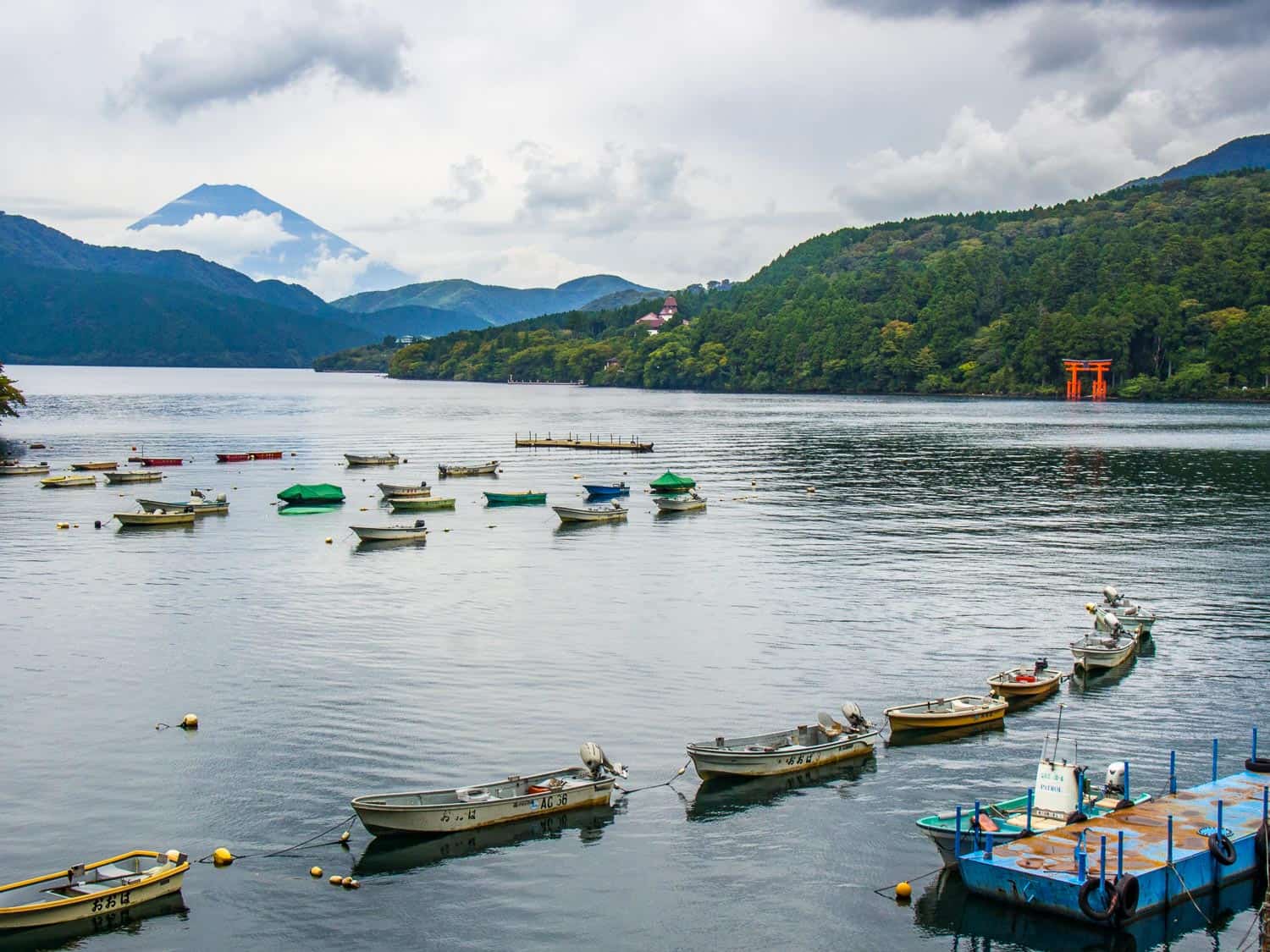
Hakone is an area encompassing Lake Ashi and the mountains around Gora.
It’s known for its views of Mount Fuji, hot springs, and the unique loop that takes you to all the sights on different forms of transport.
We began at midday by Lake Ashi in Moto Hakone where we were staying. It was a cloudy day so our hopes of seeing the reclusive Mount Fuji were dashed, but as we walked along the lake the iconic mountain appeared through the clouds.
It lived up to our expectations and the fact that it kept disappearing and reappearing through the day only made the sight more special.
We hopped on the pirate ship (yes, really!) to head across the lake for more views of Mount Fuji and the surrounding mountains.
At Togendai we switched to the ropeway (cable car) which took us up the mountain to Owakudani. We were delighted to see Mount Fuji on the way up and from the top.
Owakudani is an active volcanic valley so steam and a bad smell rise from the yellow earth.
The Japanese love the black eggs that are cooked in the hot sulphur springs, but we passed.
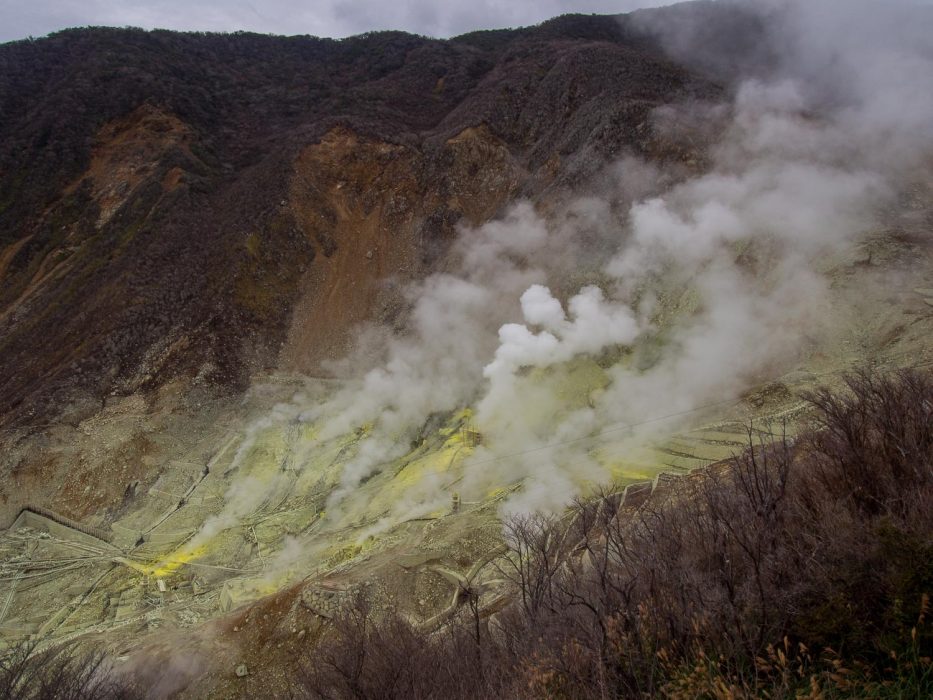
From Owakudani you can continue on the cable car to Sounzan then down to Gora, but from there we would have had to take the bus back to Moto Hakone, so it made more sense for us to return the way we came and keep enjoying the Fuji views.
We got off the boat a stop early at Hakone Machi and walked the 2 km back to our hotel which took us through the ancient Cedar Avenue.
We spent the rest of the afternoon soaking in an onsen and enjoying our wonderful ryokan room.
In the morning we walked through the mist and drizzle to the nearby Hakone-jinja shrine with its large red torii gate overlooking the lake.
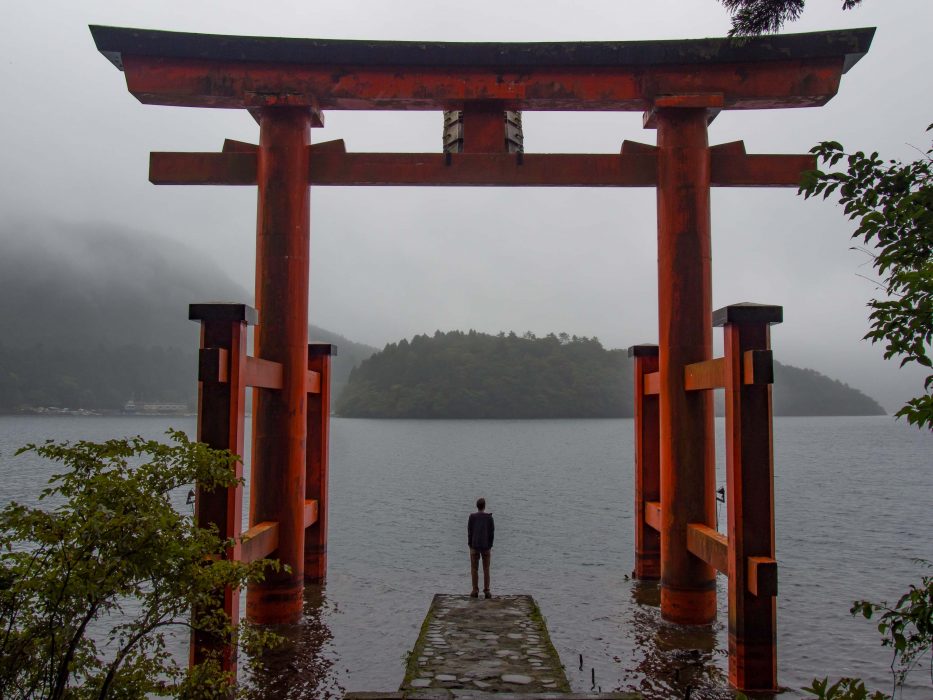
On our way back to Odawara station we continued with the loop by taking the bus to the Ninotaira Iriguchi stop and walking to the Hakone Open Air Museum.
This is a highlight of the area with outdoor sculptures, unusual art installations, a Picasso gallery, and even a free hot spring foot bath. There are lockers for luggage.
From the nearby Chokokuno-Mori station we took the Tozan mountain railway on a winding track through the forest to Hakone Yumoto where we switched trains to Odawara.
Although we managed to complete most of the Hakone loop in 24 hours, we would have loved to stay an extra night and have more time to enjoy our beautiful ryokan.
Hakone Transport
To get to Hakone from Nikko we had to backtrack through Tokyo so it was an exhausting morning of travel.
We left at 7.30 am and took the local train to Utsunomiya, the bullet train from there to Tokyo, and another bullet train to Odawara.
In Odawara train station, we bought a Hakone Free Pass at the Odakyu Sightseeing Service Centre. The pass costs 5000 yen ($32), is valid for two days, and can be used on the buses, pirate ship, cable car, and mountain railway.
As we were staying in Moto Hakone, we took the H bus there from Odawara which took about an hour on a windy mountain road and arrived around 11 am.
Where to Stay in Hakone
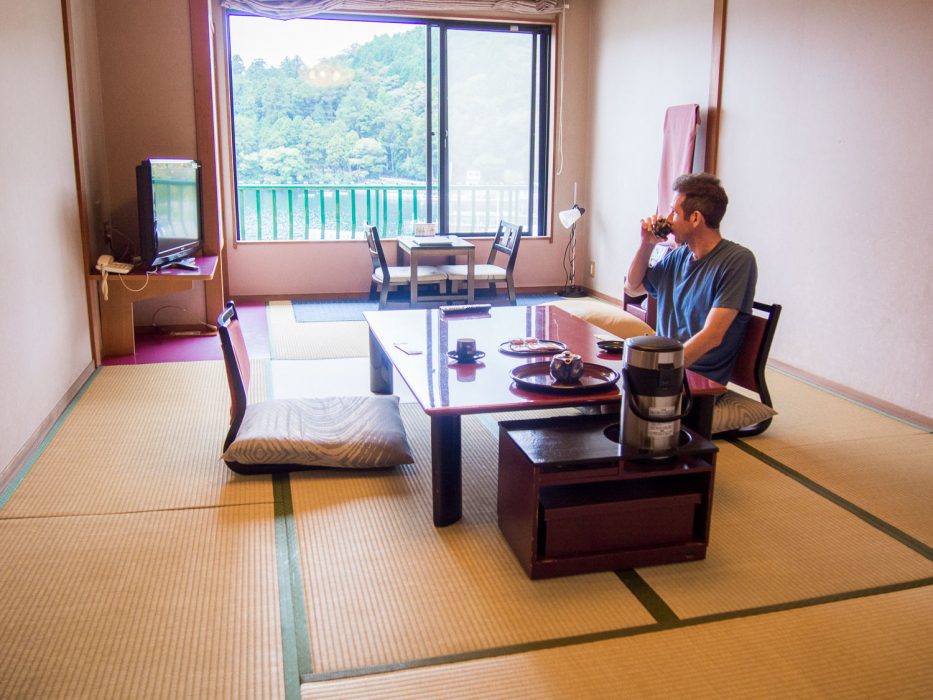
As Hakone is a large area it can be confusing deciding which town to stay in. The most important thing is to stay somewhere with good transport links.
We decided to stay in Moto Hakone next to Lake Ashi to have a second chance of seeing Mount Fuji in the morning. We do recommend the area but book a hotel with meals included as restaurants in the area are limited.
We stayed in a ryokan (traditional inn) called Hotel Musashiya, which has now closed.
A few other options by the lake are:
- Yoshimatsu – A highly-rated traditional ryokan with beautiful gardens a short walk to the lake. Private and public onsens are available.
- Hananoyado Fukuya – A traditional ryokan a few minutes’ walk to the lake. Some rooms have private onsens.
- Hakone Hotel – If you prefer Western beds, this is a good option with lake views from many of the rooms. There are shared indoor and outdoor onsens and two restaurants.
You can search for more hotels in Hakone here.
Where to Eat in Hakone
Vegetarian options are limited in Hakone.
When we arrived in Moto Hakone we had a quick lunch at Bakery and Table—you can choose from a number of rolls (stuffed with cheese, potato, etc) and pastries and take them upstairs to eat overlooking Lake Ashi.
Dinner and breakfast were included at our ryokan and they were happy to cater for vegetarians (give any dietary requirements before you arrive).
I recommend having dinner at a ryokan on at least one night of your trip as it’s always a real feast (and adventure!).
Days 8 – 9 Takayama
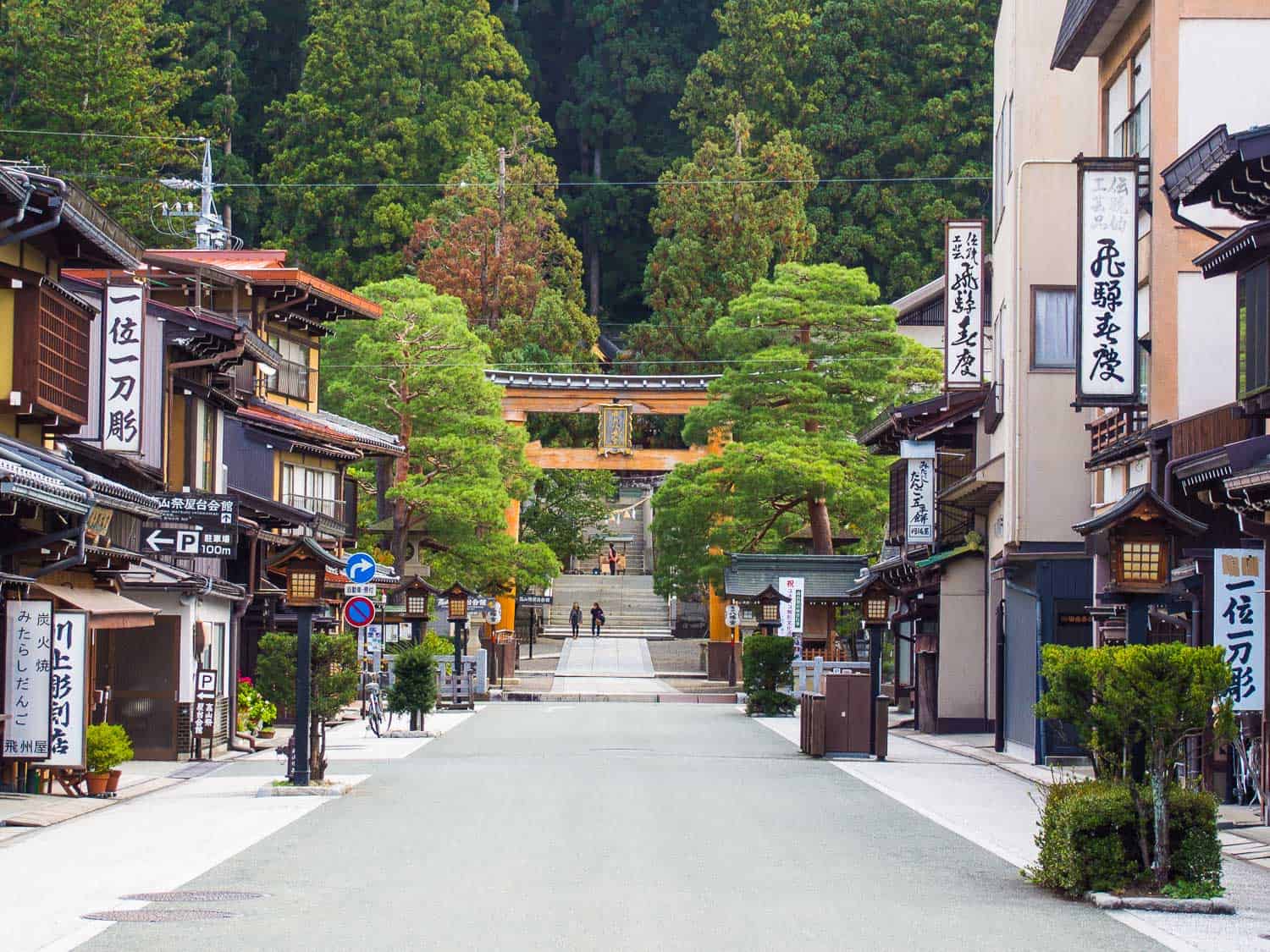
Takayama is one of my favourite places in Japan.
It’s a small town on the edge of the Japan Alps with a beautifully preserved historic centre of wooden houses, temples, neatly shaped trees, and bright red bridges over the river.
There’s so much to do in the area we could easily have spent longer than two nights here (a theme of our trip!).
Our highlights included:
- Wandering the old town in the early morning before the crowds arrived.
- Buying delicious apples and pears from the morning markets.
- Admiring the extravagant, colourful floats at the Festival Floats Exhibition Hall (Takayama Matsuri Yatai Kaikan).
- Visiting the Hida Folk Village, a display of traditional thatched houses from the area.
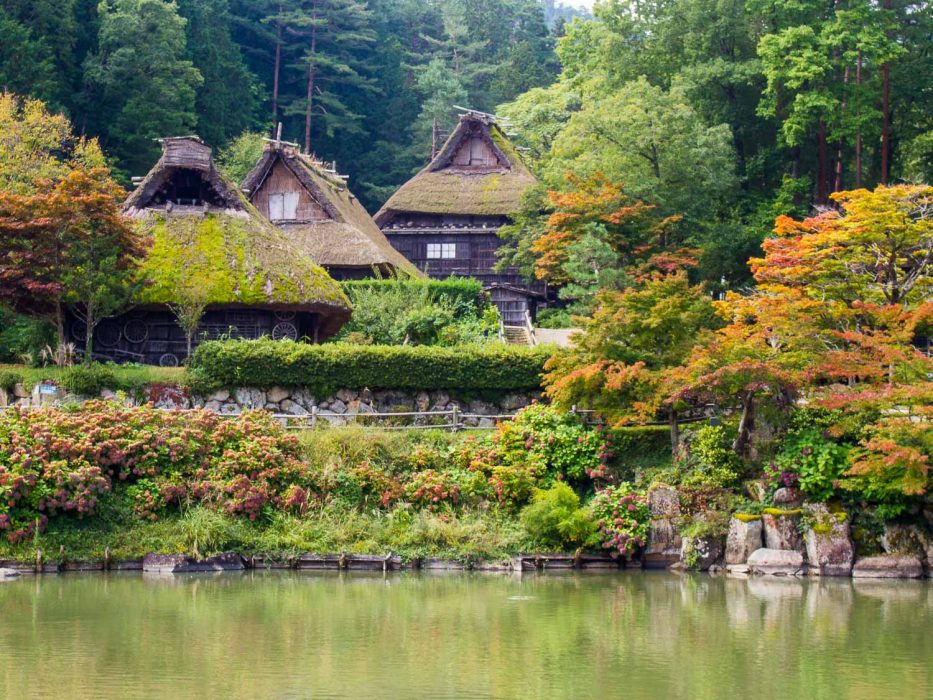
We also spent an afternoon in nearby Hida Furukawa, an adorable town that’s well worth a visit.
We did an excellent (and easy) cycling tour with Satoyama Experience where we biked through the beautiful countryside past rice fields and idyllic villages and learnt about the traditions of the area.
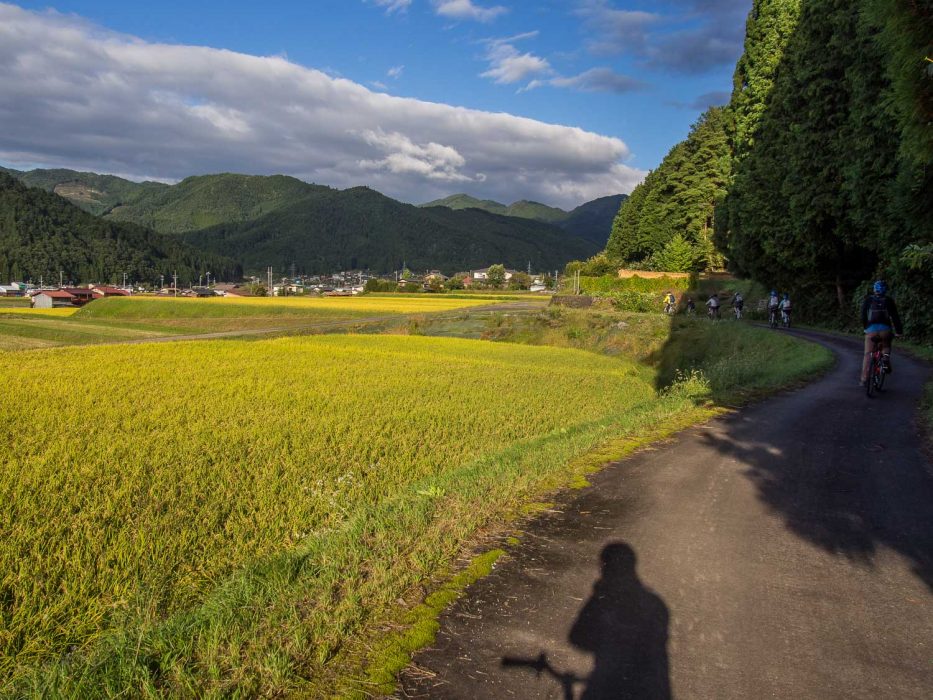
Takayama Transport
From Hakone to Takayama we took the 2.08 pm bullet train from Odawara to Nagoya then changed to the Limited Express Wide View Hida train to Takayama, which has large windows to take advantage of the beautiful river and mountain views.
We arrived in Takayama just after 6 pm.
Takayama is a small town so we walked everywhere except when we took the 15-minute train ride to Hida Furukawa for our cycling trip.
Where to Stay in Takayama
We stayed at Super Hotel Hida Takayama, an affordable business hotel close to the station and a 10-minute walk from the old town.
Our room was tiny but had everything we needed—ensuite, desk, fridge, kettle, WiFi, and free breakfast buffet.
There’s even an onsen, but we didn’t have time to use it.
Takayama is ideal for experiencing a traditional inn or ryokan. Next time we’d stay somewhere more atmospheric like the highly rated Oyado Koto No Yume.
See the full range of accommodation in Takayama here.
Where to Eat in Takayama
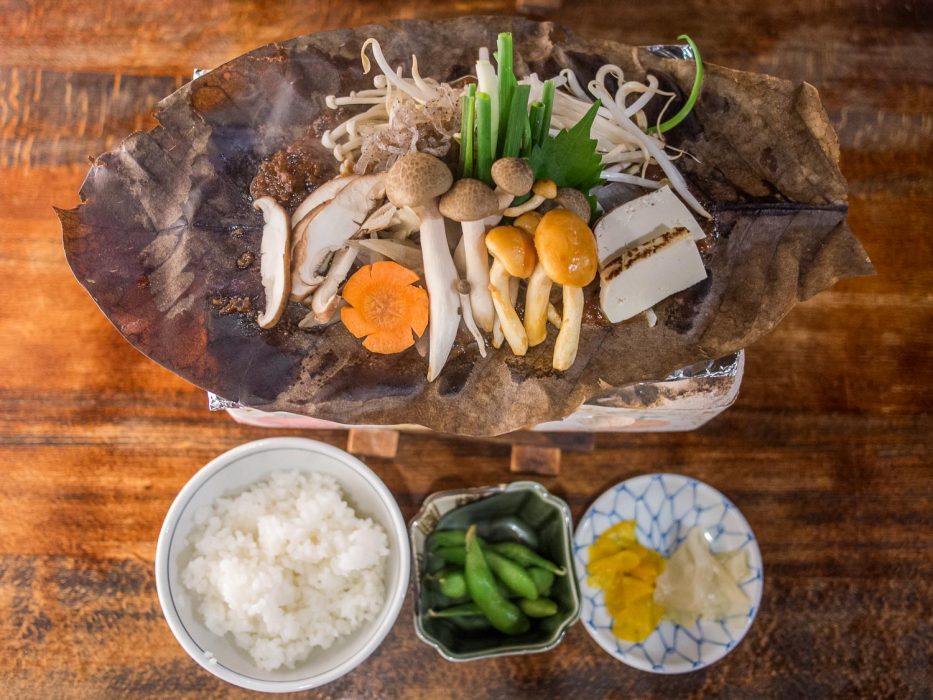
Our favourite place to eat in Takayama was Heianraku, a tiny restaurant run by the friendliest lady we’ve ever met!
There’s a multiple page vegetarian section on the menu with a mix of Chinese and Japanese dishes including local specialities like the delicious Hida miso ramen.
The chile tofu and vegetable gyoza were also excellent, and don’t miss their homemade plum wine.
Suzuya is a good place to try local specialities. They do a tasty vegetarian version of hoba miso where vegetables and tofu are cooked at your table on a large magnolia leaf spread with miso paste.
Fukutaro is a cute cafe that makes excellent gohei mochi, mashed rice grilled on a skewer with sesame sauce.
Mitarashi-dango is another local dish to try—small, almost creamy rice balls grilled with soy. The Jinya Dango stand near Jinya Mae market makes the best in town.
Days 10 – 11 Kanazawa
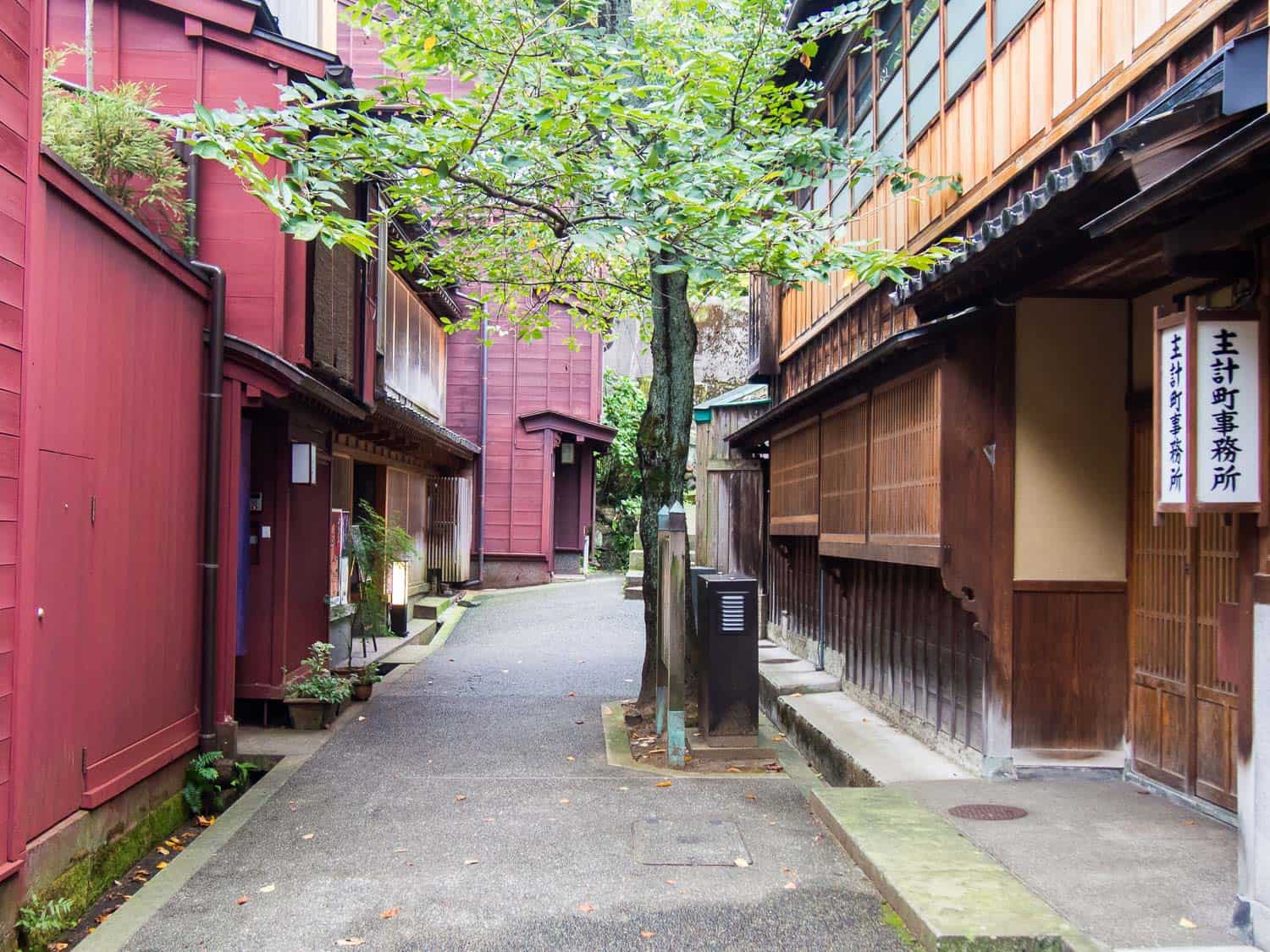
At first glimpse Kanazawa seems like another Japanese concrete city, but when you begin to explore you’ll discover some of the most beautiful gardens in the country as well as three geisha districts with preserved wooden buildings.
Higashi Chaya is the largest geisha area where geisha used to perform and entertain guests in the wooden teahouses dating back to 1820.
It’s beautiful but crowded with tourists and souvenir shops. We preferred the quieter geisha areas of Kazuemachi and Nishi Chaya.
Kenroku-en Garden is one of the top three gardens in Japan. It’s known to get crowded but we had it almost to ourselves at 7.30 am. The gardens are lovely but they would be better in the spring or autumn.
I actually preferred the tiny but exquisite Gyokusen-en Gardens which has all the classic Japanese garden elements in a small package—moss covered rocks, stone lanterns, carp-filled ponds, a wooden teahouse, and maple trees beginning to turn red.
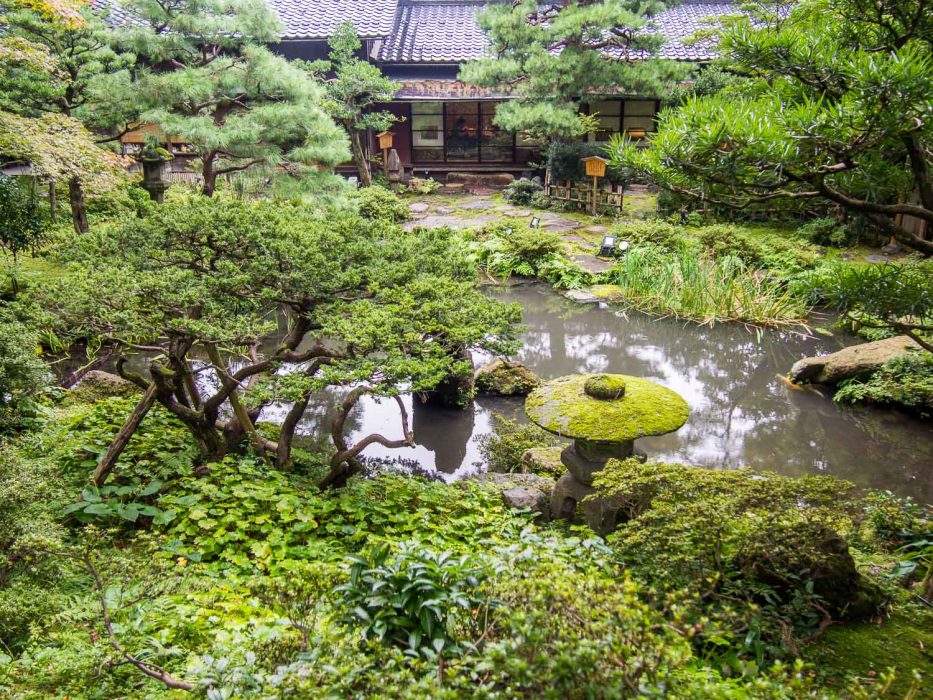
One of the highlights of our trip was the tea ceremony with did with Ms Nishida who is from the fifth generation of the family who owns the gardens.
Wearing an elegant kimono she took us through the rituals of the ceremony, starting with washing our hands and mouths to purify ourselves.
In the tatami room we were served a sweet mochi (rice cake) while she carefully prepared the bright green matcha tea by whisking the powder with hot water in a small bowl.
We learnt the phrases to say to our host and other guests before drinking the tea and how to examine the tea bowl afterwards to appreciate every detail. We then made our own tea for each other.
It was a calming experience and fascinating insight into Japanese culture.
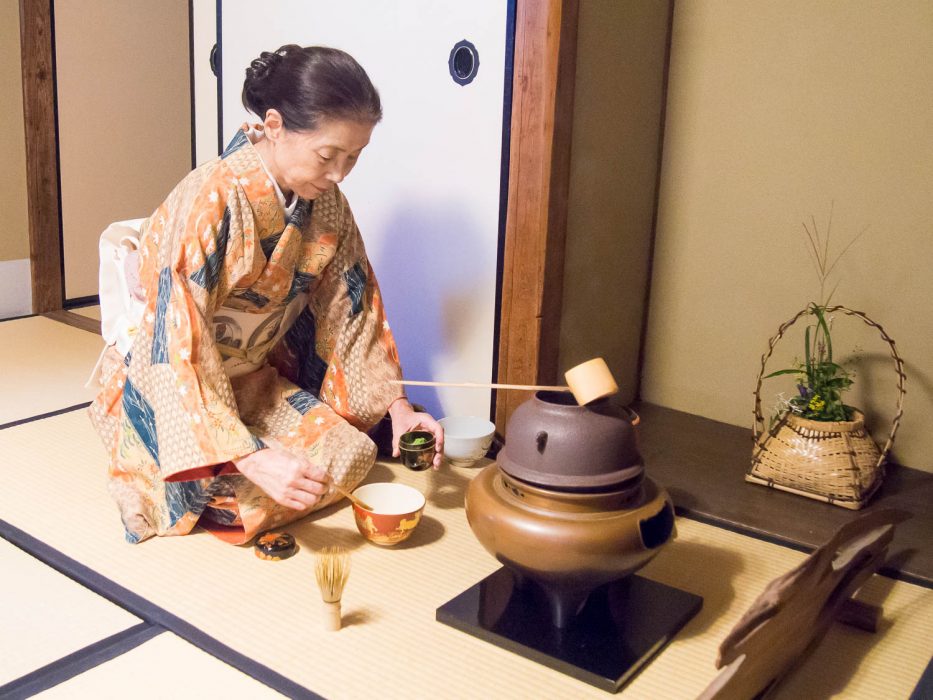
To book the tea ceremony call the gardens (see the Gyokusen Gardens website) or email [email protected] at least three days in advance (response by email can be slow). It costs 4000 yen ($26) including entrance to the gardens.
Kanazawa Transport
After spending the morning in Takayama we took the 1.15 pm train to Toyama—another beautiful journey past mountains, rivers, and rice fields—where we switched to the bullet train to Kanazawa. The journey took two hours.
Kanazawa is a large city so we had to take a 10-minute bus ride from the train station to the Katamachi area where we were staying.
From there we could walk to all the main attractions.
Where to Stay in Kanazawa
There are lots of hotels in Kanazawa and we found it one of the best value cities in Japan. We stayed in an inexpensive business hotel (no longer available).
I recommend staying close to Kenroku-en to be within a 30-minute walk of most sights.
A trendy option in a good location is Kaname Inn Tatemachi.
Find more hotels in Kanazawa here.
Where to Eat in Kanazawa
We struggled to find Japanese vegetarian food in Kanazawa so ended up eating Western food.
Slow Luck is a tiny place with four tables run by two young Japanese guys. They make creative, Italian-influenced dishes using organic farm vegetables.
There’s a vegetarian section of the menu and they give you a survey to fill in with what you can’t eat.
The food was amazing including grilled vegetables with a wonderful basil dip and a thin, crispy pizza topped with pesto, potato, and mascarpone cheese that was so good we ordered another one.
Oriental Brewing in the Higashi Chaya area serves craft beer brewed in-house and excellent beer yeast french fries. The pizzas looked good too.
Days 12 – 16 Kyoto
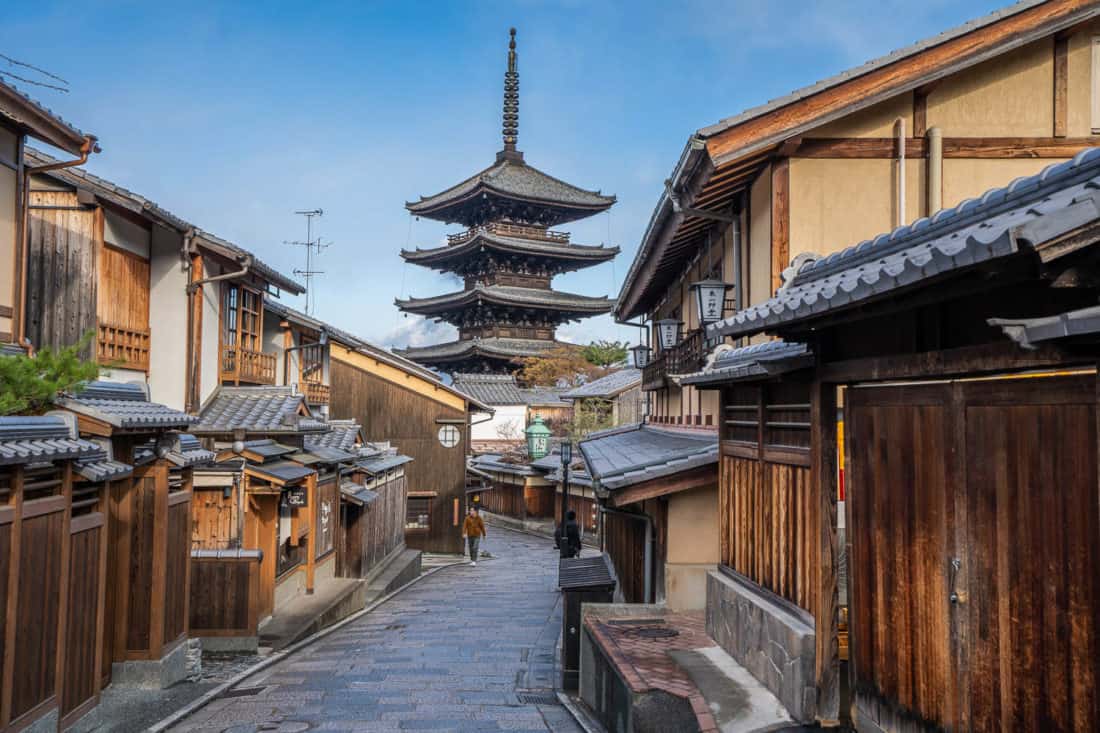
Although on this trip we returned to Tokyo (2.5 hours on the train from Kanazawa), I recommend spending the last 3-5 days of your trip in Kyoto, our favourite city in Japan.
There are so many beautiful temples and traditional streets to explore.
It’s 2.5 hours from Kanazawa to Kyoto on the Thunderbird Limited Express train.
After your stay, you could then fly out from nearby Kansai International Airport near Osaka (easily reached by train from Kyoto) or take the bullet train back to Tokyo (2 hours 40 minutes).
Since we travelled this two week Japan itinerary, we’ve returned to Kyoto for two month-long stays and we loved it even more than on our first visit (despite the increase in tourists).
See our Kyoto guides to help plan your stay:
- 26 Unforgettable Things to Do in Kyoto
- Where to Stay in Kyoto: Recommended Hotels and Areas
- 14 Stunning Places to See the Kyoto Cherry Blossoms (if you are visiting in late-March/early-April)
- 20 Best Vegetarian Restaurants in Kyoto
- 14 Best Day Trips from Kyoto
Alternative Japan Destinations
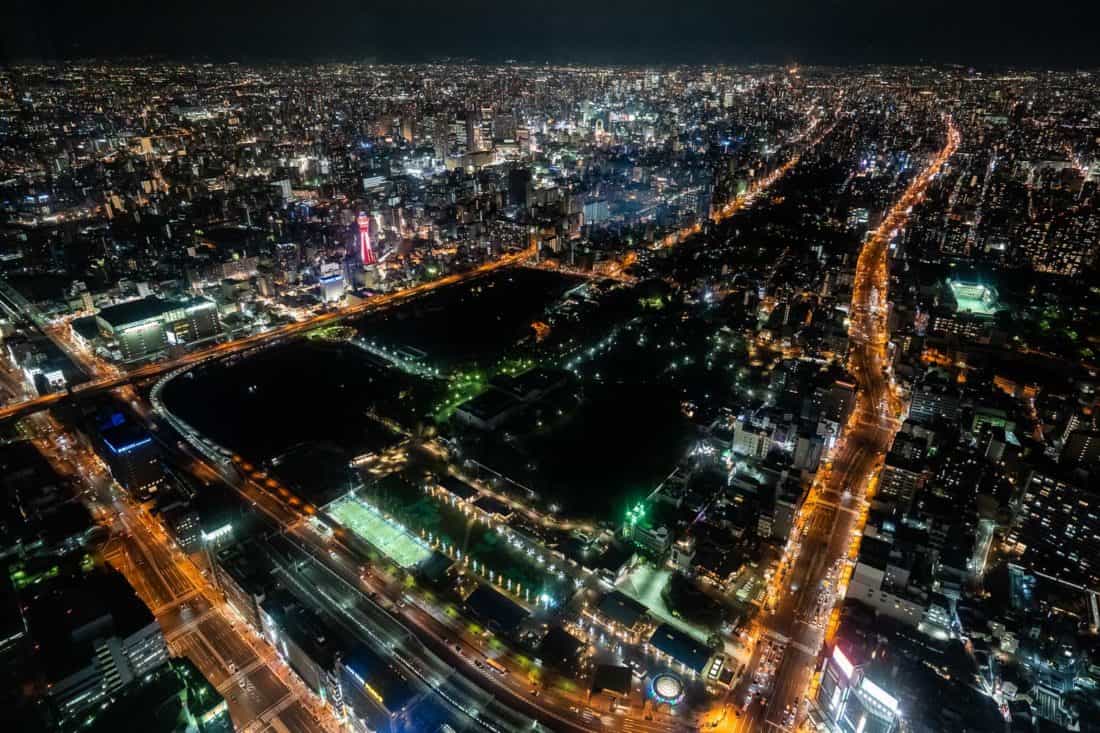
If you have more time or decide to get a 14 Day Japan Rail Pass and spend more time travelling and less in Tokyo, you could consider these destinations that we’ve enjoyed on various Japan trips:
- Osaka – A fun city with delicious food, the vibrant Dotonburi area, and the Universal Studios Japan theme park (featuring Harry Potter and Super Nintendo Worlds). You could visit as a day trip from Kyoto or add on a night before flying out from Kansai airport.
- Kinosaki Onsen – Take a break from sightseeing in this beautiful hot spring town, wander around in a kimono, and relax in one of the seven public onsen. Read our Kinosaki Onsen post for everything you need to know including onsen etiquette.
- Nara – Beautiful temples that are an easy day trip from Kyoto or we loved staying overnight at the magical forest ryokan Tsukihitei.
- Koya-san – A temple town in the mountains a few hours from Osaka where you can stay the night in a Zen Buddhist temple.
- Tsumago – A picture-perfect traditional village of wooden houses in the Kiso Valley.
- Hiroshima – To see the moving Peace Memorial Park and Museum and the nearby island of Miyajima.
- Okayama – Get off the beaten track and use this affordable city as a base for exploring the area. I especially recommend it in cherry blossom season. See my Okayama Japan travel guide for more details.
- Kawaguchiko – The views of Mount Fuji are even better here than in Hakone, but it’s trickier to add into this itinerary.
See our posts on 16 Unmissable Places to Visit in Japan and 56 Top Things to Do in Japan for more ideas.
Japan Travel Resources
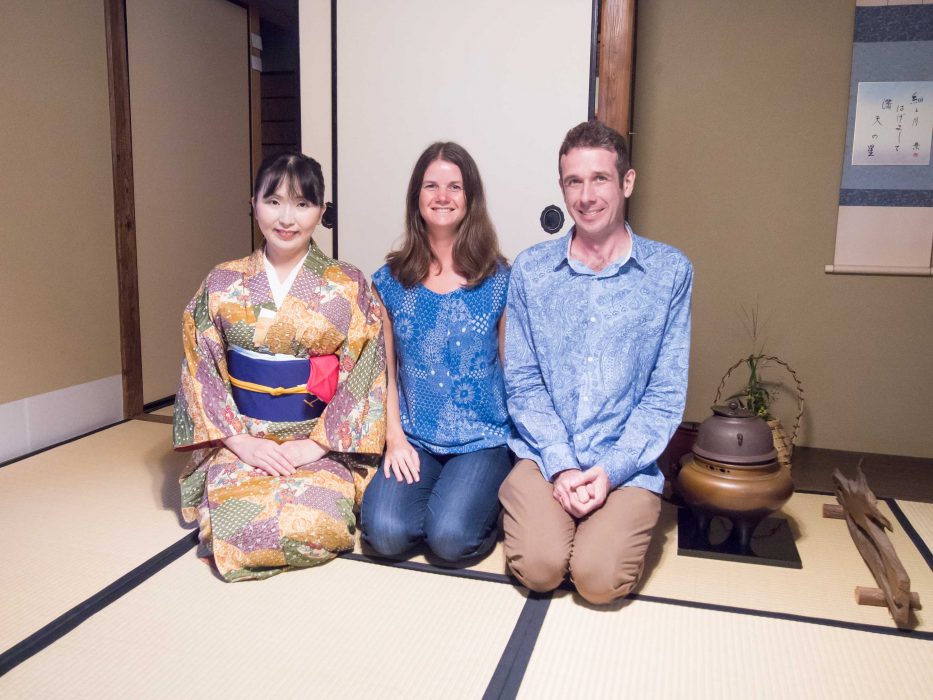
- Japan Rail Pass – Make sure you order your pass online before you go to Japan.
- Travel Insurance – Essential in case anything goes wrong as Japanese healthcare is expensive. We used True Traveller —they are the best deal we’ve found for UK and EU residents. SafetyWing is another affordable option that’s available worldwide.
- Guide Book – We used Lonely Planet Japan.
- Accommodation – We use Booking.com for hotels and ryokans.
- SIM card – We use Airalo eSIMs. They don’t require a physical SIM and you can set it up before you arrive. Check out the Japan eSIMs on Airalo.
Summary
This two week Japan itinerary is the perfect introduction to the country for first-timers, and it’s also ideal for second-time visitors like us who want to revisit Tokyo and/or Kyoto as well as explore some new places.
We hope you enjoy this wonderful country as much as we did!
Japan Travel Blog Posts
Explore more of our guides to Japan.
- Planning a Trip to Japan: Dos and Don’ts
- 16 Unmissable Places to Visit in Japan
- 56 Unforgettable Things to Do in Japan
- Where to Stay in Japan: The Ultimate Guide to Accommodation
- Is a Japan Rail Pass Worth It?
- Vegetarian Survival Guide to Japan
- 26 Unforgettable Things to Do in Kyoto
- 26 Cool Things to Do in Tokyo
If you liked this post, pin it!
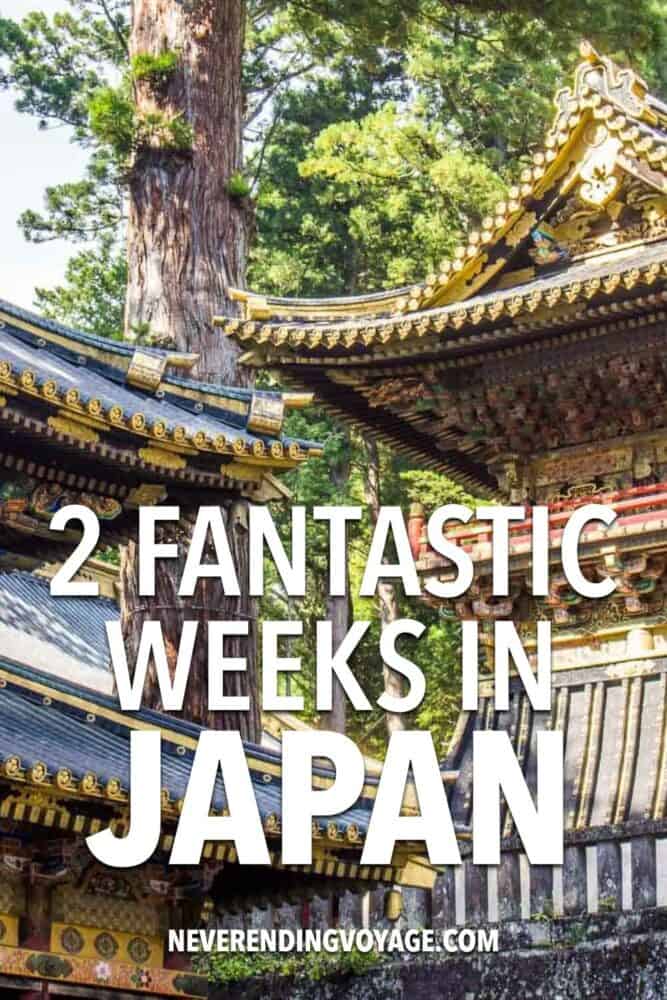
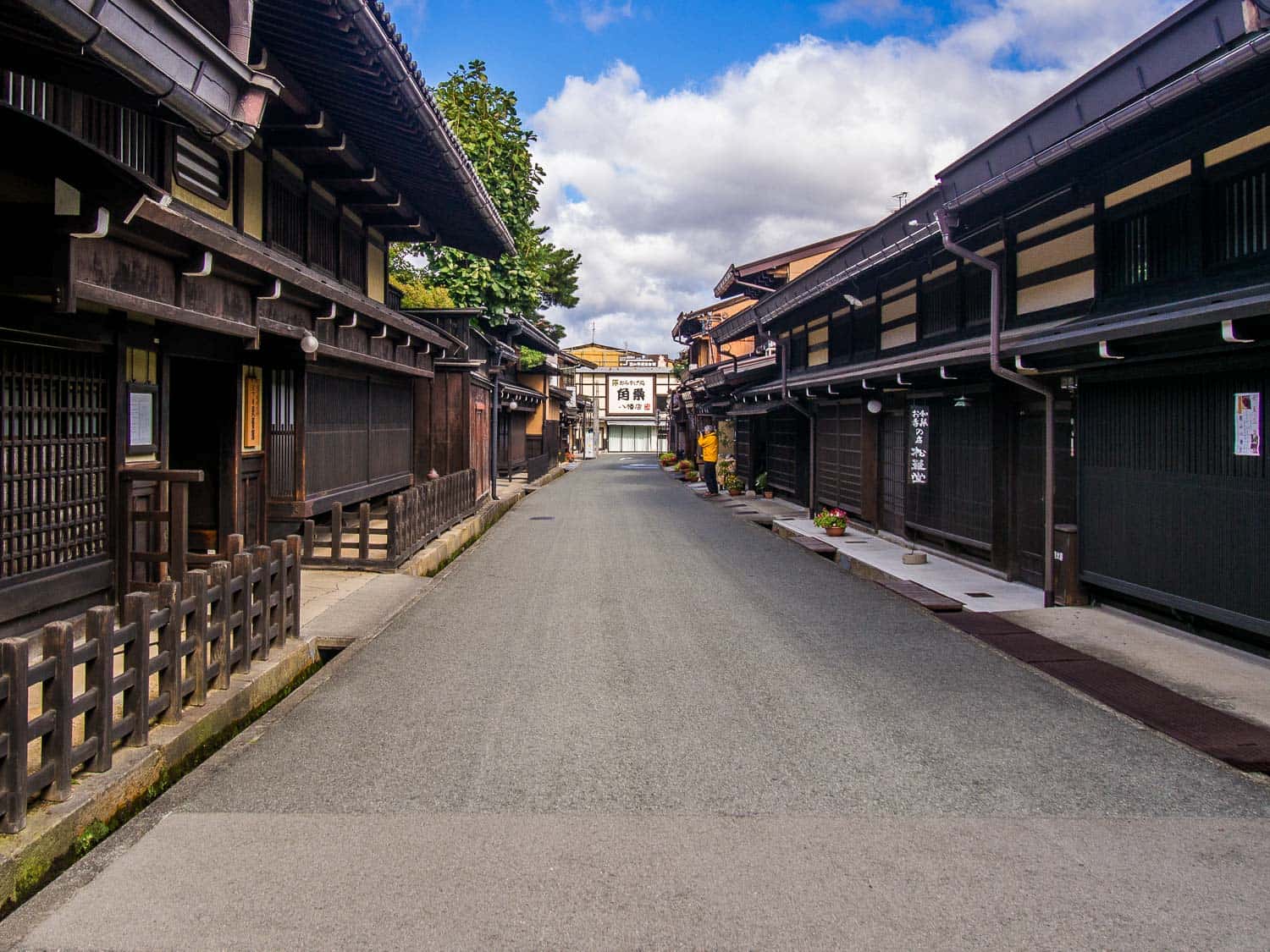
Thanks for sharing your itinerary, it is very helpful. We are planning a travel to Japan from 27th of September to 13th October. We are thinking to do 4 nights in Tokyo, one in Kanazawa, one in Takayama, one in Kyoto, one in Hiroshima and two is Osaka. We have one night that we don’t know if we should use to extend our time in one of the cities mentioned above or visit a different one. Also, this itinerary would mean we are spending the weekend in Kyoto which we would like to avoid for the crowds but I am not sure how to do it! Any feedback would be helpful, thank you!
I definitely think you need more time in Kyoto (3 nights at least). I would prioritise it over Osaka unless you have a particular reason to visit. I’m not sure how you avoid the weekend in Kyoto, but I wouldn’t worry too much. You are not going at peak season and you can go to the most popular attractions early (again, having multiple nights helps with this).
Enjoy Japan! Erin
Hiya. We r planning to travel at the same time as you did, but this year 2025. Would u be happy to share your experiences? Recommendations? Please?
Do you have any other recommendation’s on where to stay in Hakone that is still convenient for the itinerary you did? I tried doing Hotel Musashiya, but the website/google says it is permanently closed… Thank you for this blog! My husband and I are planning a trip for next year and your blog is really helping me out!
Oh that’s a shame – it looks like they closed last month. I don’t have any specific recommendations – I would search for Moto Hakone in Booking.com and see where comes up. Anywhere in walking distance of Hakone shrine would be great. Enjoy Japan!
Marvelous information and loved the links to the different things you mention. Thank you for taking the time to put it together. I’m planning to go this year and have questions weather to go with a travel company or go on my own. How difficult is it to get around on your own without knowing japanese. Are there any local tour guides you would recommend?
We’ve never used tour guides (except for a few specific activities) and have managed to get around fine without Japanese. Sometimes there are challenges and confusion but the Japanese people are very helpful and Google Translate is handy! Plus signs are in English in train stations these days. I hope you enjoy Japan however you choose to travel there! Erin
As everyobe says – amazing blog thank you. Im looking at following it for a family trip (with teenagers), and replacing the second Tokyo visit for Kyoto as you suggest. Would you recommend flying in and out from Tokyo (direct flights to and from London)? I guess that would mean a train back to Toyko at the end of our trip… is that the most sensible option do you think? Secondly, are there any nice beach locations you recommend that we may beable to include? Thanks so much Sam
Hi Sam,
It would be more convenient to fly into Tokyo and out of Kansai/Osaka airport, but there aren’t direct flights from Kansai to London.
It’s only 2hrs 15 minutes on the fastest Nozomi train from Kyoto to Tokyo, so it’s not too hard at the end of your trip (although you may need a night in Tokyo before a morning flight). That’s exactly what we did before travelling back to London last month.
We actually haven’t spent any time at the beach in Japan but Kamakura is an easy day trip from Tokyo.
Have a wonderful time in Japan! Erin
Hi Erin
I’m literally at the start of thinking about planning a trip to Japan for my partners 40th in 2025 and this itinerary sounds perfect and has really inspired me!!
I’m going to need to start a savings pot for this holiday but can you tell me how much you spent overall? How much were flights? And did you book and pay for everything separately?
Would really appreciate a jump start to my plans!
Thanks in adavance
I don’t know the overall cost and our flight costs wouldn’t be useful as we travel to Japan one way from various places around the world (most recently from Cairns, Australia for example). You can check sites like Kiwi for flight costs (although I prefer to book direct with the airlines).
We do always book and pay for everything separately. I have updated our Planning a trip to Japan post with what we booked in advance and when for our latest trip.
Good luck with the planning!
Hi Erin,
Thanks for putting this information out there – it is so helpful as I start to plan our Japan family holiday.
A problem we have though, is that our children have sensory issues and would absolutely refuse to eat most of the traditional / everyday food Japan has to offer. How easy is it to come across western-style food options in the places that you mention in your first-timer 2 week itinerary?
You’ll be fine in the bigger cities as there are McDonalds, Starbucks, and lots of Italian restaurants if they like pizza/pasta. The smaller towns like Nikko and Hakone will be more challenging. I would look at Google Maps for towns like that and search for food that your kids like (burgers etc) and see if anything comes up.
You could also try convenience stores which are known for their surprisingly decent food in Japan. As vegetarians we stick to plain rice balls, but there are also sandwiches, pot noodles, and a hot counter with stuff like fried chicken and fries.
Bakeries are another good option – you often find them near train stations.
Mos Burger is a Japanese burger chain that could maybe work.
Hi Erin, what a wonderful piece of work. The information is so useful for my planned 2 week trip next late September. I have a question or 2. This will be our 2nd visit. First time it was Kyoto 3 nights and Tokyo 5 (Rugby world cup). We are foodies and part of our return trip will be this focus along with all the natural wonders of this country. I was particularly interested in your comments of having a base and doing day trips rather than lots of mini stays. Initially i planned 5 nights Tokyo, 1 overnight Onsen stops on way to Takayama 2 nights and Kanazawa 1, then skipping Kyoto to see Osaka Hiroshima and Mayajima…but what a shame to miss a bit more of Kyoto? so maybe no Onsen on way and just do 4 stays in Tokyo- but day trip to Onsen, then Takayama and Kanazawa, and finally Kyoto with day trips to Osaka, and Hiroshima and Mayajima. Do you think that makes more sense and is quite do able, probably offering a more chilled experience?
Kyoto is our favourite place in Japan and even with repeat extended visits, we still never run out of places to see.
It is a good base for day trips too. Definitely Osaka (maybe go afternoon/evening so you can enjoy dinner and the lights at night). Hiroshima/Miyajima is a much longer day trip but it is doable if you get an early start.
You could maybe look for a ryokan with an onsen in Takayama to have that experience there.
Enjoy!
What would you suggest for a three weeks in October?
Hi Julie, October is a great time everywhere. It depends how much you want to move around. You could follow this itinerary and add more time in various places, especially Kyoto.
If you want to add some extra places, you could head further south to Hiroshima and Miyajima.
Or if you want to see some autumn colour, it’s too early for Kyoto and Tokyo, so you’ll need to head further north or up into the mountains.
Options that are easy to add onto this itinerary are Kamikochi (a mountain town near Takayama) or the Nikko area (take the bus from Nikko town to Chuzenji Onsen/Kegon Falls or Yumoto Onsen).
Enjoy!
thank you so much for the clear explanation. I really appreciate it.
Can you guys tell me how much money will needed for all of these travels above ?
You can see the budget section in the post for a rough idea.
Hi! This is super informative for our upcoming first-time visit to Japan. Do you think it’s okay to visit Osaka as a day trip or should we stay overnight? Tentative: 5 nights Tokyo, 2 nights Takayama, 1 night Kanazawa, 3 nights Kyoto and 3 nights Tokyo. We’re flying in/out of Tokyo and hoping to get by with 7 day JR pass. Also, wanted to visit Hakone, but not enough nights – or I suppose we could do as day trip from Tokyo-and pay separately? i.e. not part of JR pass?
Honestly, I’d be tempted to skip Osaka. It makes most sense to do a day trip from Kyoto, but you only have 3 nights in Kyoto and there’s so much to do there. Plus Osaka is more similar to Tokyo, where you have plenty of time.
You can do Hakone as a day trip from Tokyo and pay separately. You can’t use the JR pass from Odawara (where you change to get to Hakone) anyway and you can buy the Hakone Free Pass with the option to include the train from Shinjuku: https://www.odakyu.jp/english/passes/hakone/
Have a wonderful trip!
Thank you! This is so helpful!
Hi there,
This site is amazing. I have written down so much.
I have so much that we want to do in 2 weeks and was wondering if you could suggest the best way to go about it.
Tokyo
Disneyland
Kyoto
Universal studios
Hiroshima
We have two kids who do not want to miss these things.
A possible itinerary would be Tokyo (including Disney) – Kyoto – Hiroshima – Osaka (for Universal). You can get the train everywhere. If you can fly into Tokyo and out of Osaka that would be ideal or you can just get the train back from Osaka to Tokyo.
For Disney, if you just want one day in the parks you can do a day trip from Tokyo. If you want to visit both parks in two days, it might be easier to spend a couple of nights close to the park before moving on to Kyoto. We’ve done it both ways and like staying near the park to avoid a busy early morning commute, but changing hotels is the downside.
Have a wonderful trip!
What an amazing guide! Do you think these prices are still pretty accurate united states dollar wise? When was your trip in which you spent around $238 a day? Also I am allergic to wheat/gluten, eggs, and dairy so eat vegan and gluten free… maybe some fish here and there. Is it hard to eat gluten free in Japan?
That trip was about 4 years ago. If anything you get much more dollar to the yen these days so I don’t think prices will have gone up too much. Of course, it’s difficult to say what will happen when the borders finally reopen. Prices (for hotels etc) may go up if there’s a lot of pent up demand.
I’m afraid I’m not sure about gluten free eating in Japan.
After trawling through so many sites I found your guide absolutely marvellous. So many great tips, and a true travellers experience.
I will be travelling on my own, it’ll be my first time to Japan so your advice has been really helpful. I don’t want to miss out on anything so I’ll make sure I take on board all your recommendations.
I didn’t have any idea how long to stay in Japan so I’ll base it on 2 weeks as I’ll be travelling on to other countries afterwards. Thank you for taking the time to share all your knowledge, I’ve found it really helpful
Hi Lisa, Thanks for the kind words! 2 weeks is a great introduction to Japan, although if you’re like us, it’s never enough!
Hi Erin
Again thank you for your very informative blog!
We’re travelling to Japan in April (my daughter and I) and was hoping you could suggest some accommodation preferably hotels near transport. I have yet decided whether to purchase a JR rail pass.
We will be in Tokyo then (as per your suggestion) Kawaguchiko and from there to Kyoto then Osaka
Thank you
Maria
Hotel Sunroute Plaza is close to Shinjuku Station in Tokyo.
We liked Kawaguchiko Lakeside Hotel. It’s a longish walk from the train station but near a bus station and the hotel will pick you up from the station.
You can’t get any closer to the train station in Kyoto than Hotel Granvia although we prefer to get a taxi to Gion and stay there.
There’s also a Hotel Granvia in Osaka Station.
Enjoy Japan!
This is the first Japan travel website I have found whee I found myself agreeing with pretty much all of your recommendations, not just for which cities and towns to visit but what to do in those cities and cities. Amazing. One clarification – there is no bullet train from Kanazawa to Kyoto. Not yet, anyway, although it is being built. I suspect you were thinking of the Thunderbird train instead.
Thanks very much Steve! I’ve updated the post now as you’re right – it’s the Thunderbird train not a bullet train from Kanazawa to Kyoto.
Thank you for putting together this information, it is very valuable for planning our next trip to Japan.
Thanks Kyle! I’m glad it helped and have a wonderful trip!
Hi guys, such valuable information. Thank you! I am hoping you could help me make a decision on which places to visit, if I am planning to visit Japan for 10 days. I was going through your blog and every place listed in the 2 weeks trip to Japan seems unmissable. Can you please suggest, places to visit for 10 days. I will be travelling with elderly people (80’s) and vegetarians. Looking forward to your suggestions. Thank you!
I would recommend Tokyo, Hakone, Takayama and Kyoto. You’ll have an amazing time wherever you go! Enjoy!
Absolutely LOVING your Japan guides. I have already taken your advice and booked Shinjuku in Tokyo and adding extra time in Kyoto. I stumbled upon your site when looking for vegetarian food in Japan, I have a feeling you will be a life savers. I will be there in mid-December, do you have any extra tips for things to see in winter, in addition to the above?
thanks
I’m so glad you’ve found them useful, Sudeep!
Winter is great for onsens so you might want to consider visiting an onsen town like Kinosaki Onsen: https://www.neverendingvoyage.com/kinosaki-onsen-japan/
If not, Kurama onsen in the mountains near Kyoto is supposed to be nice and you can easily visit on a half day trip. It’d be nice after hiking from Kibune. More details in this post: https://www.neverendingvoyage.com/things-to-do-in-kyoto-japan/ (we did the hike in the summer so didn’t use the onsen).
Have an amazing trip! Erin
Erin,
My wife and I will be going to Japan next year, and were thinking about going the last week of September and the first week of October like you did. With that being said, how was the weather?
Thanks!
It was pretty hot in Tokyo (made 25ºC) and cooler at higher elevations like in Takayama (especially at night when it got pretty chilly). We had some rain, some sunny days. Layers are the way to go as you’ll need to be prepared for everything! It depends where you go though – Tokyo and Kyoto should be warm but norther north or higher up will be colder.
It’s a quieter time of year so I think it’s a good time to visit. Enjoy!
Wow, my husband and I are planning 3 weeks travelling around Japan in March/April 2020 and I am so glad I found your report. My husband worked in Tokyo for 3 weeks and managed a few weekends out sightseeing but had always talked about going back. We are only in the initial stages of planning but this is really helpful especially as I am pescatarian and although my hubby eats meat, he is the chef at home so cooks veggie and fish (we don’t buy meat) and if he fancies meat he eats this when we are out.
We are in our early 50’s but love to walk and cycle around and don’t like package deals or organised tours. We live in Greece so have sun and beaches for 9 months of the year so our holidays are based around food, culture, sightseeing and new experiences. Great tips on travelling light, I hadn’t even thought about a big suitcase and moving from hotel to hotel, the JR pass in advance and veggie cards to take and learning a few words, we have the whole Winter to learn (Greeks hard enough though!)
The colours and the food look amazing, we are so looking forward to 3 weeks of planning. A big thank you from us ….. India next so we will be back ….
Spring is a wonderful time of year for Japan so I’m sure you’ll have an amazing time. I have some more posts coming soon about our spring trip, especially using Okayama as a base for some more off-the-beaten track locations. I mentioned a few in this post: https://www.neverendingvoyage.com/kyoto-cherry-blossoms/
You’ll be fine as a pescatarian in Japan as there are plenty of fish-based dishes.
Good luck with the planning!
Erin,
I rarely… And I do mean rarely – ever make comments in regards to travel blogs. I honestly am so impressed with the amount of information and meticulous detail that you have included on Japan. The content is compelling enough to keep me engaged throughout the entire peace. I can honestly say it is the best that I have ever seen. I hope that your sponsorship/advertisers understand what true value you are offering to people and comfort when it comes to making decisions, saving money, and more. You truly are a master in the field of travel blogging.
I wish you all the best in your future travels and blogging, I will definitely be reading.
Thank you Geoff for your very kind words – that means a lot!
This is great inspiration for a first timer to Japan. I will be using it lots for plan my trip next March. Thanks!
Thank you so much for all this write up about you Japan trip. Really a great read! We as family of four are planning to see Japan this last week of October thru the first week of November, hoping to see the splendor of the season of fall in that region. Anxious about this trip, your blog has made my planning a lot easier. Thank you!
Have a wonderful time in Japan, Noel!
Hi Erin. I am hoping to plan a 2 week tour in Japan in April 2021 for my Dragon boat team of 25 women. Would you still suggest your itinerary for such a large group? I am in the initial stages of planning and I am open to any hints that you can offer.
Thx so much. Gloria
I would say it’s possible. Maybe skip Nikko though to reduce the number of one night stays. I imagine travel days might be a bit complicated with a big group so consider visiting fewer places and staying for longer. You could also visit Nikko as a day trip from Tokyo. Good luck with the planning!
What is the cost of this two week trip? My cousin and I are saving up to go to Japan for two weeks next June.
See the budget section of this post :)
Hi,
This is a very good and exhaustive writeup . Thanks again. This helped me streamline my itineraries better. I have one concern though and it is on the AirBnB accomodation. Is it OK for you to suggest the best way to choose one here? I am also looking out in Shinjuku area.
Thanks
The way I find somewhere on Airbnb is to type Shinjuku Tokyo into the search bar then choose homes, your dates, number of guests, home type (entire place) and then use filters to narrow things down (for example we like to have wifi, kitchen, washer, and air conditioning in the summer).
I then use the map view to zoom in to around the Shinjuku station area and see what’s available. If there aren’t any you like them remove a filter or widen the area of the map. I recommend choosing a place that has at least 5 reviews. Feel free to message a host if you have any questions before you book.
Good luck with it!
Erin
Hi, we are a family of 4 and planning to visit next Nov 2019. Thank you for sharing your journey it sounds and looked amazing. Hope to follow some of your trips but not planning to stay 2 weeks.
So just wanted to thank both of you for sharing your experiences and photos. I now have an idea what to expect and cost wise as well.
Thank you
All the way from New Zealand
Thanks for the feedback Sharlene and have an amazing time in Japan!
Hi Erin,
Your series of posts about Japan is amazing! The details you include are definitely invaluable. I am in the very preliminary stages of planning a 2?-week vacation there (my wife and daughter pester me weekly, if not daily, to go; I was born in Kyoto, been back once, but don’t remember much of it, besides the food).
I do have some questions for you, hope you don’t mind:
how did you figure out the “little things” (for example, As we were staying in Moto Hakone we took the H bus there from Odawara; On our way back to Odawara station we continued with the loop by taking the bus to the Ninotaira Iriguchi stop and walking to the Hakone Open Air Museum). did you plan these in advance? did you ask locals? you just stumbled up on these?
I presume you don’t speak fluent Japanese (forgive me, if you do), but were you able to get assistance, if you needed? Between my wife, my daughter, and myself, we may be able to get by, but I’m curious.
Did you encounter many situation when your JR pass couldn’t be used?
Thanks again for taking the time to write and post your experiences.
Charles
Hi Charles
I’m so glad you’ve found the posts useful.
I figure out the little things by doing a lot of research online in advance. So for Hakone I studied the Hakone free pass map and found the bus timetable and map. I’m sure we could have also asked our hotel but I like to be prepared!
I only speak a few words of Japanese but we managed to get by fine. On our last visit we noticed that many more locals spoke English than on our previous trip. People are really helpful – when we look confused at a train ticket machine at the airport, for example, a young Japanese guy approached us to help (he spoke English). Google translate is also really useful – we used the camera feature a lot to translate food labels (as we’re vegetarian we have to be more careful). It’s definitely worth getting a SIM card for your phone so you can translate things and use Google Maps to get around (we never needed to ask for directions).
On our last two trips we couldn’t use our rail pass to get to Mount Koya and in Hakone (where we bought the pass at Odawara). We also had to get a slower train from Tokyo to Nikko. It still worked out good value for us even paying for the extra tickets.
I hope you do make it to Japan!
Erin
I love al the info you have about Japan. I am super excited as I am planing in visiting 2020 spring time. I will be traveling along for 3 or 4 weeks. If anyone has recommendations or any helpful advice about places I should visit, please leave me a message. thank you
We’re in Japan right now. Spring is a lovely time to be here – don’t miss Kyoto as the cherry blossoms are amazing. I’ll be writing more about spring/cherry blossom season travel in the next few months so look out for those posts (or sign up to our newsletter https://www.neverendingvoyage.com/newsletter/).
Wow, this article is fantastic! I’m currently planning my trip to Japan for the 2020 Olympics, which will knock off 2 items from my bucket list! :). Thanks for sharing your adventure. I will surely take notes and consider your recommendations.
I’m glad you enjoyed it and hope you make it for the Olympics!
Amazing website and all the links is helping me plan our trip to Japan this summer. We only have booked our tickets, its time to fast track on booking accommodation. Cant wait to see the beauty of Japan!
I’m really glad you found it useful. Have an amazing trip to wonderful Japan!
Thank you ! I find this very interesting and useful for my up coming trip to Japan in summer 2018. This will help me plan my family trip to Japan without having to pay so much to the travel agency. Thank you again and i m very much appreciate the sharing of your Japan trip.
Please let me know Anita if you have any questions and good luck with the planning!
Hi . Been searching for travel tips going to Japan and Im so glad I found your blog.
Will surely follow your suggestions. Cant wait to go to Japan next year. Booking our trip now while its cheaper. Thanks for all your insights, really helps.
More power and more traveling.
I’m glad you found it useful and have an amazing trip to Japan!
Japan seems to one of the world’s hottest travel destinations at present. I’ve been just once and would love to return. Thanks for the handy advice.
Tourism numbers have been growing at a rapid rate there. I’m not surprised as it’s a fascinating country. We’re already planning our third trip!
Nice interesting post, thank you for sharing it ! Japan is such a beautiful and awesome country.
Thank you. It is an amazing place.
I’ve been wanting to go to Japan for years now, but it’s always been just a bit too far out of the way on our travels. I’ve seen videos of the maricart tours before and they look fun. I’ve never heard of tofu skin – was it good?
I can’t recommend it enough Rhonda. My biggest regret is that we waited six years to return – put off by the cost. It is absolutely worth some effort to get there as it’s such a unique place.
Japan does tofu like nowhere else -there are actually tofu speciality restaurants (not vegetarian either). The tofu skin has a pretty subtle flavour but I like it.